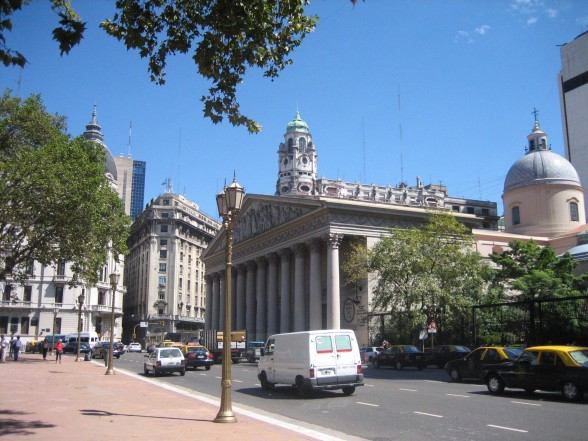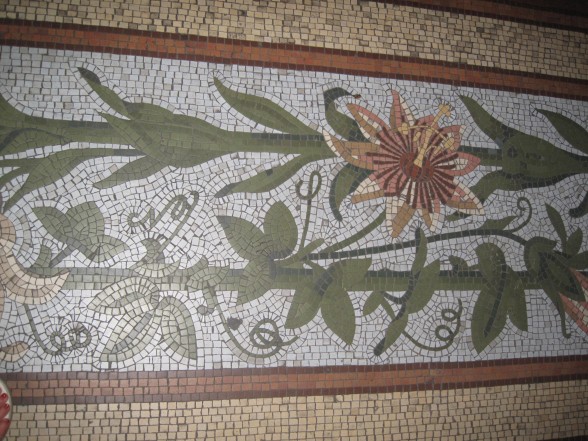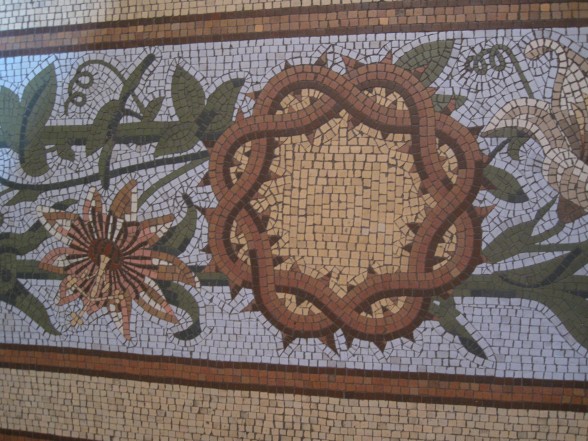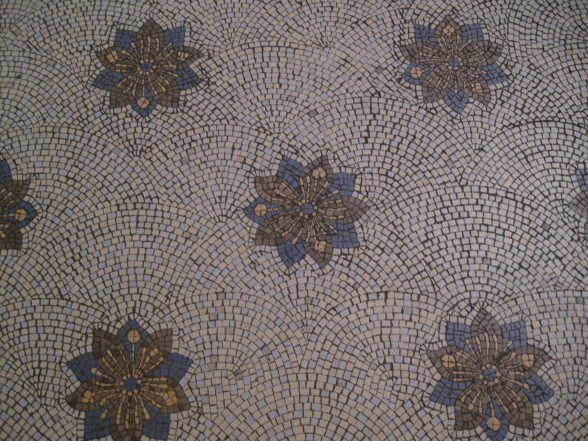The floor of the Cathedral of Buenos Aires is a work of art in itself. It was laid it in 1907 to mark Argentina’s centennial. Repair work was begun in 2004 and was finished in time to mark the country’s 200th anniversary in 2010.

A short history of the cathedral
The current building is the last of a series of buildings that occupied the plot allotted to a church by the founder of Buenos Aires, Juan de Garay, in 1580. The first church was built of wood and adobe and was replaced in 1605. As the building was in danger of collapsing, it was rebuilt in 1618. In 1620, the church was made seat of the Diocese of Buenos Aires and thus its status changed to cathedral.
The church was rebuilt twice more, in 1664 and 1684. In 1752 the roof of the nave collapsed and due to extensive damage, the whole structure had to be rebuilt. The pace of construction was so slow that when the cathedral was consecrated in 1791, it still didn’t have a façade. The façade was finally added in the 19th century and was designed in the neoclassical style. It consists of a tall portico, twelve columns and a triangular pediment.
The layout is that of a Latin cross with a transept and three aisles. Frescoes were added in the late 19th century. There are some works of art from the colonial period (17th and 18th centuries), like the guilt wood altarpiece or the statue of the Christ of Buenos Aires (1671).

The floor
The black and white chequered tile floor laid in 1830 was replaced by Venetian mosaic tile between 1907 and 1911 to celebrate Argentina’s centennial. The passion flower was chosen as the motif depicted throughout the whole area (2,600 square metres or 28,000 square feet) is the passion flower because it symbolises the Passion of Christ. Its filaments represent the Crown of Thorns; its stamens represent the Five Holy Wounds; the styles represent the Nails of the Cross and the petals, the Twelve Apostles.

White, pink and lavender varieties of the passion flower were used in the design of the floor. Each one was painstakingly created with small tiles imported from England. They were laid first on sheets and then carefully transferred onto a bed of sand and lime. It took five years to complete.
About a hundred years later, the cathedral authorities decided it was time to carry out some repair work in time for the celebration of the country’s 200th anniversary.
When I was at school, we went to the Cathedral on a field trip. Our guide explained to us everything about the tiles, which we call mosaico bizantino. Later that week, we had to recreate the technique by pasting tiny squares of coloured paper creating a design on a sheet of construction paper. It drove me insane because I’m not very patient and don’t pay much attention to detail. I can safely say that the artists who did the tiling at the cathedral earned my respect and admiration.

Read more
Argentinean customs: have your soda water delivered to your door
Ceibo, Argentina’s national flower
From Argentina to the Netherlands for Love blog




I don’t really remember what the floor of the cathedral in BA is like. It looks really nice and you’re right, the people that did this work deserve all our praise and respect indeed.
I like the motif they chose for the tiling.
This reminds me I have so much I want to see in Bs. As. and that I should be going back soon.
Really beautiful tile work on those floors.
I like very much this kind of mosaico! So beautiful!
They are beautiful. I don’t remember doing anything this creative at school – I don’t think art was a big priority in our curriculum. Not sure I would have had much patience with it either though!
Superb mosaic!
Aledys: we must meet in BA sometime 🙂
Sophie, DeeBee, Sandra: I thank you on behalf of the artists 🙂
Liz: I was excited at the beginning but when I realized how much work it entailed, I wasn’t so happy 🙂